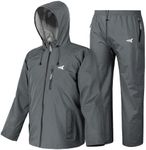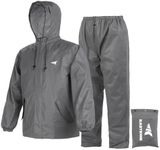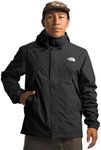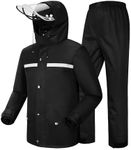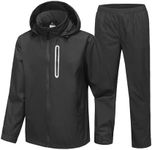Buying Guide for the Best Rain Suits
Choosing the right rain suit is essential to stay dry and comfortable during wet weather. Whether you're planning to use it for outdoor activities like hiking, cycling, or just for daily commuting, there are several key specifications to consider. Understanding these specs will help you make an informed decision and select the best rain suit for your needs.Waterproof RatingThe waterproof rating indicates how well the rain suit can keep water out. It is usually measured in millimeters (mm) and refers to the amount of water pressure the fabric can withstand before leaking. Ratings typically range from 1,500mm to 20,000mm or more. For light rain and short periods outdoors, a rating of 1,500mm to 5,000mm is sufficient. For moderate rain and longer exposure, look for 5,000mm to 10,000mm. For heavy rain and extended periods, choose 10,000mm or higher. Consider your typical weather conditions and activity duration to determine the right rating for you.
BreathabilityBreathability measures how well the fabric allows moisture from sweat to escape, keeping you dry and comfortable inside the suit. It is usually measured in grams (g) of water vapor that can pass through a square meter of fabric in 24 hours (g/m²/24h). Ratings range from 5,000g to 20,000g or more. For low-intensity activities or short durations, 5,000g to 10,000g is adequate. For moderate activities, 10,000g to 15,000g is better. For high-intensity activities or long durations, 15,000g or higher is ideal. Choose based on your activity level and how much you sweat.
MaterialThe material of the rain suit affects its durability, weight, and comfort. Common materials include PVC, polyurethane, and Gore-Tex. PVC is durable and completely waterproof but can be heavy and less breathable. Polyurethane is lighter and more flexible but may not be as durable. Gore-Tex and similar fabrics offer a good balance of waterproofing and breathability, making them suitable for active use. Consider how often you'll use the suit, the type of activities, and your preference for weight and comfort.
Fit and SizeThe fit and size of the rain suit are crucial for comfort and effectiveness. A suit that is too tight may restrict movement, while one that is too loose may let water in. Look for adjustable features like cuffs, hems, and hoods to customize the fit. Consider layering underneath the suit, especially in colder weather, and choose a size that accommodates this. Try on the suit with your typical clothing to ensure it fits well and allows for easy movement.
Seam SealingSeam sealing prevents water from seeping through the stitched areas of the rain suit. There are three types: fully taped, critically taped, and welded seams. Fully taped seams have waterproof tape on all seams, providing the best protection. Critically taped seams have tape on the most exposed areas, suitable for moderate conditions. Welded seams are fused together without stitching, offering excellent waterproofing and durability. Choose based on the level of waterproofing you need and the conditions you'll face.
VentilationVentilation features, such as pit zips, mesh linings, and back vents, help regulate temperature and reduce sweat buildup inside the rain suit. These features are especially important for high-intensity activities or warm weather. Pit zips are zippers under the arms that can be opened for airflow. Mesh linings add breathability without compromising waterproofing. Back vents allow air to circulate while keeping rain out. Consider your activity level and the climate to determine the importance of ventilation features.
PackabilityPackability refers to how easily the rain suit can be folded and stored when not in use. Lightweight and compact designs are ideal for travel and outdoor activities where space is limited. Some rain suits come with their own storage pouch or can be packed into one of their pockets. Consider how often you'll need to carry the suit and the available storage space. If portability is important, look for a suit that is easy to pack and carry.
